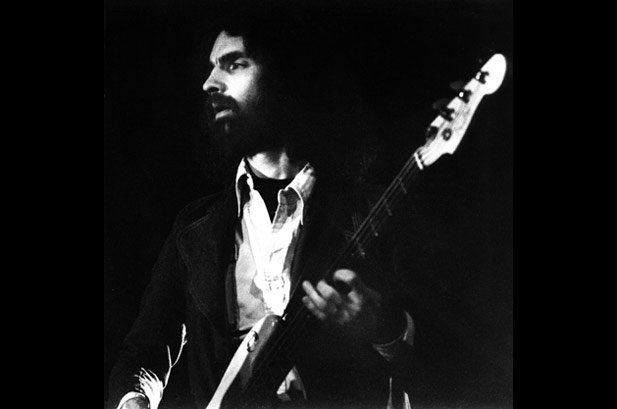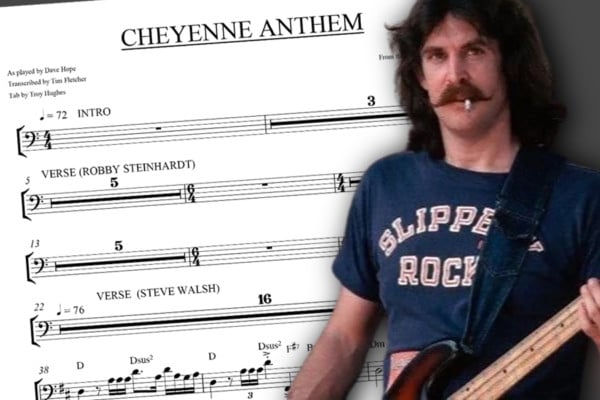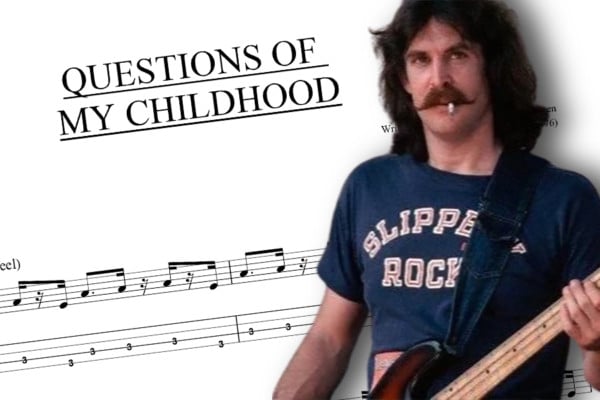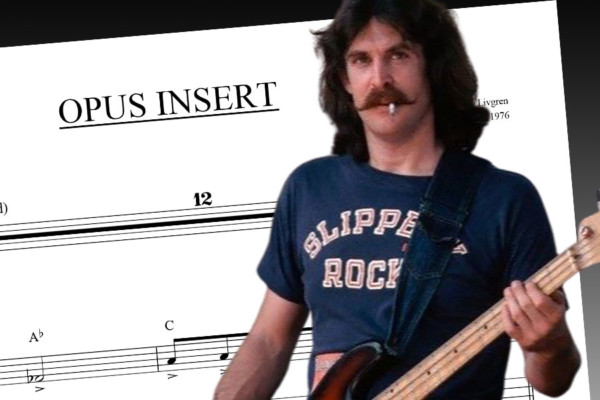Bass Transcription: Chris Ethridge’s Bass Line on “Hot Burrito #2” by The Flying Burrito Brothers

Perhaps best known for his time in various incarnations of The Flying Burrito Brothers, Chris Ethridge also had a long and varied career as a session player, appearing on well over a hundred recordings for a range of rock, folk and country artists, including Jackson Browne, Ry Cooder, Crosby & Nash, The Doors, The Everly Brothers and Nancy Sinatra. His recordings with Gram Parsons in The International Submarine Band and The Flying Burrito Brothers helped to form the beginnings of country rock, and this paved the way for artists such as The Eagles, Linda Ronstadt, and Creedence Clearwater Revival.
Chris Ethridge was born on February 10th, 1947 and he was interested in music from an early age: his first instrument was a small red toy guitar that he would use to strum along with the radio. His father’s job as an engineer at the WTOK radio station in Meridian also helped to expose him to some of the great country music stars of the era. The station featured live performances, and Ethridge’s father would bring him along to watch artists like Jimmy Rogers and Roy Acuff. However, it was seeing Elvis Presley that inspired him to become a musician; “I was just mesmerized… I just knew that I had to do that”. When he was 10 years old, his father bought him a Fender Musicmaster guitar and an amplifier, and by the time he was twelve he was playing in a band, but Chris found that “…there were five guitarists and a drummer, so somebody had to play bass”.
His father soon bought him a Fender Precision, and although he encouraged his musical endeavors, Ethridge remembers that he “…wanted me to read the notes, and I wanted to play ‘What’d I Say’” (the Ray Charles song). Ethridge was soon playing regularly in local blues and R & B bands, but his big break came in 1965 when he was working with the Pre-Dawn 5 at The Vapors Lounge in Biloxi. Johnny Rivers, a well-known singer at the time, was playing at a club across the street, and Rivers and his band would come over to jam after their show. On Rivers’ next visit, his bass player left the band after an argument, and Ethridge was asked to fill in for the remainder of their residency. This worked out so well that he was asked to join the band, and he followed Rivers to Los Angeles at the end of the run.
With the help of Rivers, Ethridge found an apartment on Sunset Boulevard, which placed him at the center of a quickly developing music scene. He soon got to know the local studio engineers and musicians, and became an in-demand session player and a regular at many of the venues in L.A. He later married Karen Sue, a waitress from the Troubadour, and eventually settled in a small house in Laurel Canyon. Ethridge continued to play with Rivers for a while and played on his albums Live at the Whisky a Go-Go (1969) and Home Grown (1971).
At the 1967 Monterey Pop Festival, Ethridge bumped into another L.A. musician, Mike Bloomfield, who told him that Gram Parsons was looking for musicians to replace bassist Ian Dunlop and drummer Mickey Gauvin in Parson’s International Submarine Band.
Ethridge contacted Parsons, he joined the second incarnation of the band, and they quickly got to work on studio sessions for their first album. Sadly, this was also to be their last. Safe at Home was recorded in 1967, but it was not released until spring 1968 by which time Parsons had left to join The Byrds, and the band had already split up. The album didn’t sell well but has been cited as one of the earliest examples of the soon-to-be-popular country rock genre. After the band folded, Ethridge went back to session work. He played on folk singer Judy Collins’ album Who Knows Where the Time Goes (1968) and also played in her band to promote the LP.
While a member of The Byrds, Parsons helped to write and record material for their seminal country-rock album Sweetheart of the Rodeo (1968), but after a show at London’s prestigious Royal Albert Hall, they fired him for refusing to take part in an upcoming tour of South Africa. Parsons then returned to L.A. and after unsuccessfully auditioning for a role in the fledgling Poco, he decided to form a new band. He recruited Chris Ethridge, Chris Hillman (who had left The Byrds in the intervening period), pedal steel virtuoso “Sneaky” Pete Kleinow and drummer “Fast” Eddie Hoh, and Parsons named his new band The Flying Burrito Brothers after the one formed by former ISB members Gauvin and Dunlop, who had now settled on the East Coast.
For a while, there were two bands with the same name; one in New York and one in Los Angeles. Once Parsons’ version had been signed to A & M, the other band folded. The band began to record their first album The Gilded Palace of Sin in late 1968, but Hoh left after recording two tracks, and guest drummers were used to help finish the album. Eventually, Michael Clarke from The Byrds was recruited as a permanent member, which meant that Ethridge was the only member of the band had not previously played with The Byrds.
The album was released in February 1969 – a combination of soul, country, and psychedelia. Although the critics praised the new sound, it was not a commercial success, only reaching #164 in the US charts. Undeterred, the band began a tour of the US to promote the album, although this was by train due to Parson’s fear of flying. The drink and drug-fuelled tour was not a great success, and with only one album under their belts, most of the band’s live repertoire focused on country standards. This may have alienated the mainstream rock fans, and Parson’s insistence on the band wearing flamboyant suits made by the West Hollywood cowboy outfitters “Nudie” potentially put off the more conservative country fans. The band liked the suits, but Ethridge commented that the audience “…didn’t know what to make of us at all”.
As an R & B bassist, Ethridge grew frustrated at the more country-oriented direction of the band, and left in the fall of 1969, just before the band appeared at the ill-fated Altamont Festival. Chris Hillman took over on bass, and praised Ethridge’s playing; “He had the feel. He was not the fanciest bass player, but that was not what it is about. He had the groove, he had it right in the pocket. I learned a lot from him”.
After he left the Burritos, Ethridge returned to his session work, including the L.A. Getaway album with Joel Scott Hill and John Barbata. Ethridge played with Gram Parsons again in the summer of 1973 to help promote Parsons’ first solo album GP, which contained “She” – another Parsons/Ethridge composition. Parsons died of a drug overdose at The Joshua Tree Hotel later that year.
In 1974, Ethridge played with Gene Parsons and Joel Scott Hill in The Docker Hill Boys, and this became the nucleus of a new line-up Flying Burrito Brothers when they reformed in 1975. This line-up recorded Flying Again (1975), and toured to promote it, but Ethridge left the band early the following year in order to return to studio work.
In 1978, Ethridge worked with Willie Nelson on his Stardust album, and this began an eight-year collaboration, playing in Nelson’s Family Band until 1986. He also appeared alongside Nelson in the 1980 feature film Honeysuckle Rose as Easter. He returned to The Burritos for their 1993 album Eye of a Hurricane but did not take part in the tour to support the album. After this, Ethridge continued his live and session work, including the 2004 album Judy Collins Sings Leonard Cohen: Democracy.
Ethridge died on April 23, 2012, at age 65 at a hospital in Meridian, Mississippi. He was best known for playing a Fender Precision, but also played Pedulla, Vox and Peavey instruments.
Hot Burrito #2
This song was written by Chris Ethridge and Gram Parsons. Ethridge recalls that “I told Gram I had a couple of old melodies from back when I was growing up. I played them for him and we wrote the two songs that day, “Hot Burrito #1” and “Hot Burrito #2,” and then that night went into the studio and cut ‘em.”
Hot Burrito #2’ features Ethridge’s flowing and melodic playing, and he brings his well-developed R & B chops to this song, which blend pleasingly with Parson’s country simplicity to create an effective hybrid of the two genres.
The bass line begins with an R&B style bass lick into the first verse that is restated many times during the song. The verses are essentially pedal C bass notes in different octaves beneath a simple Dm to C chord change played in different inversions to imply movement. Ethridge’s use of bar-ending melodic phrases in between the pairs of chords helps to keep the music flowing. In bar five Ethridge also includes a short slide-up – a technique that he uses widely in this bass line.
In bar eight the bass line becomes more driving, with more use of consecutive quavers and less syncopation than the first section, and Ethridge uses some chromatic runs to link the more varied chord changes.
The two initial sections are repeated, and then a middle section at bar twenty-four which has a more open feel, and Ethridge uses more rests alongside the fills. This section ends with a semiquaver-based run utilizing the open G string and a rising Bb-B-C idea (bar 31-2).
This is followed by further cycles of the two original sections, where Ethridge varies his note and rhythm choices – check out bar 42 where Ethridge plays a D note instead of the C pedal building tension before resolving back onto the C in bar 43. At the return of the middle section, Ethridge uses higher positions than he did before, and this section is completed using the same run as previously seen in bar 31-2.
In the outro (from bar 64 to the end), Ethridge develops his previous ideas, including more rhythmic variance (more use of semiquavers and dead notes) and more use of chromaticism. He also begins to include Bb pitches in the runs perhaps to give a little ambiguity to the line – possibly implying a Mixolydian mode.
Download the transcription and follow along with the track:


